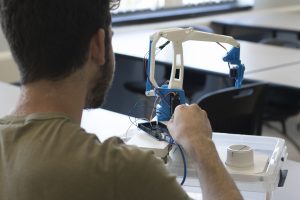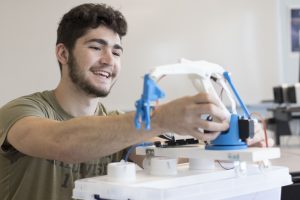Quincy College student, Aidan Doust has designed a inter-disciplinary, 3D printed, Engineering marvel that has automated the manual shellfish upwelling aquaculture process as part of an open ended final for an Introduction to Aquaculture course taught by Aquaculture Instructor Chuck Martinsen at Quincy College’s Plymouth Campus.
A Marshfield resident and graduate of Marshfield High School, Aidan started his pursuit of higher education at Quincy College to complete an Aquaculture Certification at Quincy College at Plymouth Campus. Concurrently, Aidan commutes to the Quincy Campus to pursue a Natural Science: Engineering Associates Degree.
With encouragement from Martinsen, Aidan began the hundred-hour process to build a shellfish silo automated bin cleaner. The machine would be a scale model demonstrating the automation of the shellfish upwelling process. This model in real-life could exist on land powered by a pump or be rigged on a float in the water connected to a dock. The average age of a full-time aquaculture worker is 44 years old. The job is labor intensive and automation, as designed by Aidan, could support the workforce.
” We have a population of aging employees and volunteers across aquaculture. The weight of the silos for example can range from 25 to 50 pounds. This can lead to injury and a decline of the number of workers in aquaculture long-term. In addition, there is a delay in the adoption of technical innovation in greater numbers across the industry. As such, there is a lot of opportunity and interest to use modern technology to facilitate modern oyster farming, ” Quincy College at Plymouth Aquaculture Instructor, Chuck Martinsen. Martinsen also serves as Deputy Director & Shellfish Constable, Marine & Environmental Services for Falmouth.
Martinsen elaborates: ” As we wrapped the Spring 2018 semester, I encouraged Aidan to explore a mechanical system knowing his interest in engineering that could save bodies and allow individuals to work later in life. He devised a real world solution by applying not only his aquaculture knowledge but his passion of engineering and 3D Printing. Aidan is brilliant student who gives more to the class than he takes away.”
Aidan who previously did not know programming or 3D Printing, taught himself programming, 3D printing, coded a program, designed, 3-D printed all parts, automated, and assembled half of an automated aquaculture shellfish upweller. This model weighs 5 lbs featuring robotic components and an upweller arm currently powered by a cell phone.
Reflecting on his education at Quincy College and his inter-disciplinary automated shellfish upweller, Aidan stated:
” I love the intersection of aquaculture and technology. It’s a combination of science, art, and food, ” Aidan Doust states.
Doust continues: ” Prior to my final aquaculture project, I had no programming or 3D printing knowledge. I worked with Professor Martinsen for inspiration and real-world insight and Assistant Professor of Engineering Technology, Richard Bramante who aided in the design of the power source for the automated shellfish upweller. There were several design iterations and quite a few failed 3D printed parts. I struggled with the rotation motor not having enough power.”

Quincy College student, Aidan Doust demonstrates the robotics used for his automated shellfish upweller (Image Credit: Quincy College)
When faced with challenges in completing his automated shellfish upweller, Aidan turned to several on-campus resources at Quincy College Quincy Campus:
” I am a member of the Quincy College Computer Club and I was able to explore 3D Printing, coding, and programming as an extracurricular. I even turned my bedroom at home into a laboratory of sorts with electronics, soldering equipment, circuit boards, and drawers full of wires. My father works in Acoustic Oceanography and he provided me with some supplies and support during the process. ”
With the success of the Aquaculture final project, Aidan is pursuing additional passion projects while completing his education at Quincy College including founding an International Cuisine Club and working as a work study for Quincy College Career Services. He eventually wants to pursue a Doctorate in oceanographic research. He is currently working on a marine biology project emulating ecosystems with micro organisms.
As for Aidan’s automatic shellfish upweller, when asked if he would like to build a real-world version of his model, his answer was an emphatic yes.
About Quincy College’s Aquaculture Certificate Program
Exploring the intersection of hands-on practical science and business, the Quincy College Aquaculture Certificate Program is 25 semester hours (8 courses for college credit) of introductory courses in shellfish aquaculture, practicum courses, and business management. The focus of the program is on salt-water shellfish species such as oysters.
Through the Quincy College Aquaculture program, students will not only graduate with a Aquaculture Certificate but will be YSI, HACCP and OSHA certified. These industry standard certifications ensure Quincy College graduates are entering the workforce, ready to meet the immediate needs in our coastal communities.
To learn more about Quincy College’s Aquaculture certificate program, visit: https://quincycollege.edu/program/aquaculture/.
